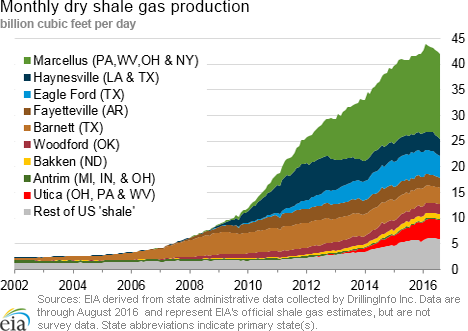In the News:
The United Kingdom's use of natural gas for power generation exceeds the three-year average in 2016, reversing previous decline
The Carrington gas-fired power plant in Manchester, England began commercial operations on September 26, 2016. This 880-megawatt (MW) facility is the United Kingdom's (U.K.) first gas-fired power plant commissioned in the past three years. In 2016, natural gas consumption for power generation (power burn) has increased considerably in the U.K. as more coal-fired power plants have been retired. Power burn increased by 43% in the first nine months of 2016 compared with the same period last year, and was 37% higher than the three-year (2013–15) average. Coal generation accounted for 23% of the total electricity generated in the U.K. in 2015. This year through July (the most recent data), the coal share of electricity generation decreased to 10%. At the same time, the share of natural gas-fired generation increased to 40% of the total electricity generated in the first seven months of 2016, its largest share since 2010, while nuclear accounted for 20%, and renewable generation and electricity imports accounted for the remaining 30%.
In 2015, approximately 12 GW of coal- and oil-fired electric generation capacity was retired, largely to comply with the European Union Large Combustion Plants Directive and the government's general policy shift toward greener energy. These retirements led to a 24% decline in coal-fired generation. Additionally, in 2015, the increase in the carbon price floor (CPF), which applies an additional tax on power sector carbon emissions, increased operational costs of coal-fired power plants. The CPF, initially introduced in April 2013 at £9.55 per ton of carbon dioxide (tCO2) (US $12.40/tCO2), doubled in April 2015 to £18.08/tCO2 (US $23.45/tCO2), increasing the cost of coal-fired generation as compared to 2014.
U.K. natural gas power burn has generally increased over the past two decades, and peaked in 2010. However, power burn declined 47% from 2010 to 2012, following a significant increase in natural gas prices from US $6.56 per million British thermal units (MMBtu) (annual average) in 2010 to US $9.49/MMBtu over the same period in 2012. Natural gas-fired generation remained at about the same level in 2012–15, while the combined share of renewable generation (particularly wind), and net imports increased from 16% to 30% over the same period.
Falling natural gas prices in 2016 made natural gas-fired power plants decidedly more competitive than coal-fired power plants. In May 2016, U.K. electricity generated from coal fell to zero on several days for the first time in 100 years. Although coal generation is expected to continue to decline with more power plant closures in the next five years, the recent approval of the 3.3 GW Hinkley Point C nuclear power plant and growth in renewable generation will affect the growth in natural gas-fired electricity generation over the long term.
Overview:
(For the Week Ending Wednesday, October 5, 2016)
- Natural gas spot prices were mixed this report week (Wednesday, September 28 to Wednesday, October 5). The Henry Hub spot price fell from $2.98 per million British thermal units (MMBtu) last Wednesday to $2.86/MMBtu yesterday.
- At the New York Mercantile Exchange (Nymex), the October 2016 contract expired last Wednesday at $2.952/MMBtu. The November 2016 contract closed at $3.041/MMBtu yesterday, up 4¢ Wednesday to Wednesday.
- Net injections to working gas totaled 80 billion cubic feet (Bcf) for the week ending September 30. Working gas stocks are 3,680 Bcf, which is 2% greater than the year-ago level and 6% greater than the five-year (2011–15) average for this week.
- The natural gas plant liquids composite price at Mont Belvieu, Texas, rose by 16¢, closing at $5.46/MMBtu for the week ending September 30. The price of natural gasoline and propane increased by 5% and 2%, respectively, while the price of ethane, butane, and isobutane each rose by 3%.
- According to Baker Hughes, for the week ending Friday, September 30, the natural gas rig count increased by 4 to 96. The number of oil-directed rigs rose by 7 to 425. The total rig count climbed by 11, and it now stands at 522.
Prices/Supply/Demand:
Spot prices fall outside the Northeast. This report week (Wednesday, September 28 to Wednesday, October 5), the Henry Hub spot price fell 12¢ from $2.98/MMBtu last Wednesday to $2.86/MMBtu yesterday. At the Chicago Citygate, prices decreased 6¢ from $2.87/MMBtu last Wednesday to $2.81/MMBtu yesterday. Prices at PG&E Citygate in Northern California declined 12¢, going from $3.41/MMBtu last Wednesday to $3.29/MMBtu yesterday. The price at SoCal Citygate decreased 9¢ from $2.99/MMBtu last Wednesday to $2.90/MMBtu yesterday.
New York sets another record low price. At the Algonquin Citygate, which serves Boston-area consumers, prices went up 9¢ from $2.36/MMBtu last Wednesday to $2.45/MMBtu yesterday, after reaching a low of $1.43/MMBtu on Friday, September 30. At the Transco Zone 6 trading point for New York, prices increased 21¢ from 86¢/MMBtu last Wednesday to $1.07/MMBtu yesterday. Following last week's record-low price of 77¢/MMBtu, prices reached another all-time low of 41¢ on Friday. This price is the lowest daily average price at Transco Zone 6 since NGI started tracking prices at Transco Zone 6 in 1998.
Tennessee Zone 4 Marcellus spot prices rose 8¢ from 76¢/MMBtu last Wednesday to 84¢/MMBtu yesterday, after falling to 32¢ on Friday. Prices at Dominion South in northwest Pennsylvania rose 14¢ from 79¢/MMBtu last Wednesday to 93¢/MMBtu yesterday. Prices at Dominion South also reached a report week low on Friday, falling to 29¢/MMBtu.
November futures up slightly. At the Nymex, the October 2016 contract expired last Wednesday at $2.952/MMBtu. The November 2016 contract increased to $3.041/MMBtu, up 4¢ Wednesday to Wednesday. The price of the 12-month strip averaging November 2016 through October 2017 futures contracts climbed 7¢ to $3.183/MMBtu.
Supply falls. According to data from PointLogic, the average total supply of natural gas decreased by 1% compared with the previous report week. Dry production fell by 2% week over week, whereas average net imports from Canada increased by 2%.
Consumption falls. Total U.S. consumption of natural gas fell by 4% compared with the previous report week, driven by a 14% decline in power burn. Industrial sector consumption increased by 1%, while residential and commercial consumption rose by 16% as some areas enter the heating season. Natural gas exports to Mexico fell 4%.
U.S. liquefied natural gas (LNG) exports. There were no pipeline deliveries to the Sabine Pass liquefaction terminal because the facility is completing the second week of the scheduled four-week maintenance of Trains 1 and 2. One vessel (LNG-carrying capacity 2.8 Bcf) is scheduled to dock at the terminal today.
Storage:
Working gas stocks post second-largest build of 2016 refill season, but are still below historical norms. Net injections into storage totaled 80 Bcf, compared with the five-year (2011–15) average net injection of 95 Bcf and last year's net injections of 96 Bcf during the same week. This marks the second-largest net injection of the 2016 refill season, just below the 82 Bcf build posted for the week ending May 27. The 2016 refill season remains on pace to be the only refill season, aside from 2012, not to post a single week that exceeds 100 Bcf—a threshold typically exceeded at least two times during the refill season. Working gas stocks total 3,680 Bcf, 205 Bcf above the five-year average and 74 Bcf above last year at this time. When the refill season began on April 1, working gas stocks were 874 Bcf above the five-year average.
South Central region posts third-largest net injection of 2016 refill season. Net injections totaled 20 Bcf in the South Central region, with salt dome facilities accounting for net injections of 14 Bcf. This week's total net injections at salt dome facilities in the region is the largest reported during the 2016 refill season, and exceeds the year-ago value of 10 Bcf for the report week. Working gas stocks at the salt dome facilities in the South Central region are 12% below last year at this time, while working gas stocks in the region are 8% higher than the five-year average for this time of year.
Net injections are above the range of market expectations. Estimates of net injections into storage ranged from 62 Bcf to 78 Bcf, with a median of 71 Bcf. The price of the Nymex futures contract for November delivery at the Henry Hub fell about 4¢/MMBtu with relatively heavy trading (1,420 trades) at the release of EIA's Weekly Natural Gas Storage Report (WNGSR). Prices reached $2.98/MMBtu within two minutes of the release.
Spread to the January futures price remains close to year-ago levels. During the most recent storage week, the average natural gas spot price at the Henry Hub was $3.01/MMBtu, while the Nymex futures price of natural gas for delivery in January 2017 averaged $3.34/MMBtu, a difference of 33¢. A year ago, the premium was 35¢.
Temperatures remain higher than normal. Temperatures in the Lower 48 states averaged 69°F, 5°F higher than normal and the same as last year at this time. Cooling degree days (CDD) in the Lower 48 states totaled 42, compared with 39 last year and a normal of 25.
See also:
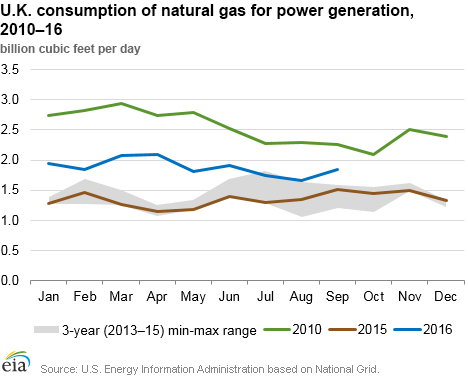
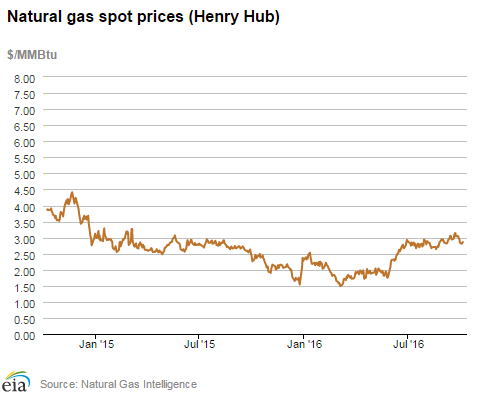
| Spot Prices ($/MMBtu) | Thu, 29-Sep |
Fri, 30-Sep |
Mon, 03-Oct |
Tue, 04-Oct |
Wed, 05-Oct |
|---|---|---|---|---|---|
| Henry Hub |
2.95 |
2.84 |
2.81 |
2.83 |
2.86 |
| New York |
0.69 |
0.41 |
1.02 |
1.04 |
1.07 |
| Chicago |
2.86 |
2.67 |
2.72 |
2.75 |
2.81 |
| Cal. Comp. Avg.* |
2.94 |
2.87 |
2.87 |
2.86 |
2.89 |
| Futures ($/MMBtu) | |||||
| November contract |
2.959 |
2.906 |
2.923 |
2.964 |
3.041 |
| December contract |
3.161 |
3.132 |
3.170 |
3.183 |
3.260 |
| *Avg. of NGI's reported prices for: Malin, PG&E Citygate, and Southern California Border Avg. | |||||
| Source: NGI's Daily Gas Price Index | |||||
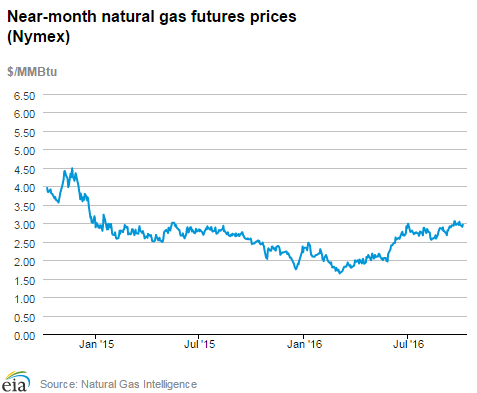
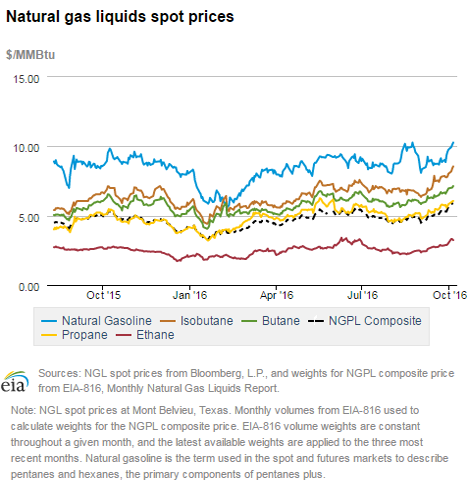
| U.S. natural gas supply - Gas Week: (9/29/16 - 10/5/16) | |||
|---|---|---|---|
Average daily values (Bcf/d): |
|||
this week |
last week |
last year |
|
| Marketed production | 78.3
|
79.4
|
81.9
|
| Dry production | 70.4
|
71.5
|
73.6
|
| Net Canada imports | 6.1
|
6.0
|
5.1
|
| LNG pipeline deliveries | 0.3
|
0.3
|
0.2
|
| Total supply | 76.8
|
77.7
|
78.9
|
|
Source: OPIS PointLogic Energy, an IHS Company | |||
| U.S. natural gas consumption - Gas Week: (9/29/16 - 10/5/16) | |||
|---|---|---|---|
Average daily values (Bcf/d): |
|||
this week |
last week |
last year |
|
| U.S. consumption | 56.0
|
58.4
|
58.7
|
| Power | 25.3
|
29.3
|
24.7
|
| Industrial | 19.7
|
19.6
|
20.2
|
| Residential/commercial | 11.0
|
9.5
|
13.8
|
| Mexico exports | 3.3
|
3.5
|
3.3
|
| Pipeline fuel use/losses | 6.2
|
6.5
|
6.5
|
| LNG pipeline receipts | 0.0
|
0.0
|
0.0
|
| Total demand | 65.5
|
68.4
|
68.4
|
|
Source: OPIS PointLogic Energy, an IHS Company | |||
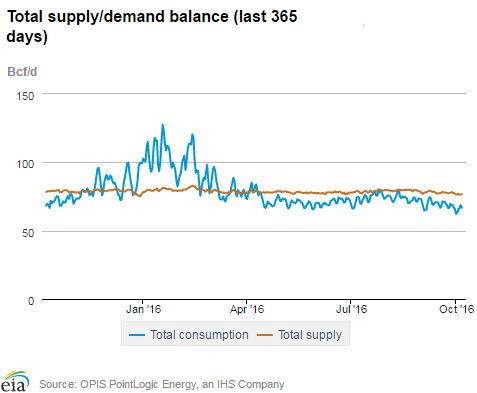
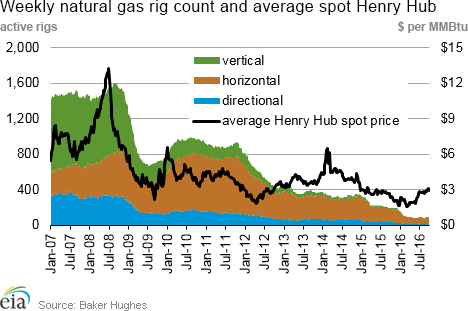
| Rigs | |||
|---|---|---|---|
Fri, September 30, 2016 |
Change from |
||
last week |
last year |
||
| Oil rigs | 425 |
1.7% |
-30.8% |
| Natural gas rigs | 96 |
4.3% |
-50.8% |
| Miscellaneous | 1 |
0.0% |
0.0% |
| Rig numbers by type | |||
|---|---|---|---|
Fri, September 30, 2016 |
Change from |
||
last week |
last year |
||
| Vertical | 64 |
6.7% |
-45.3% |
| Horizontal | 407 |
1.2% |
-33.2% |
| Directional | 51 |
4.1% |
-38.6% |
| Source: Baker Hughes Inc. | |||
| Working gas in underground storage | ||||
|---|---|---|---|---|
Stocks billion cubic feet (Bcf) |
||||
| Region | 2016-09-30 |
2016-09-23 |
change |
|
| East | 899 |
874 |
25 |
|
| Midwest | 1,045 |
1,014 |
31 |
|
| Mountain | 237 |
233 |
4 |
|
| Pacific | 318 |
318 |
0 |
|
| South Central | 1,181 |
1,161 |
20 |
|
| Total | 3,680 |
3,600 |
80 |
|
| Source: U.S. Energy Information Administration | ||||
| Working gas in underground storage | |||||
|---|---|---|---|---|---|
Historical comparisons |
|||||
Year ago (9/30/15) |
5-year average (2011-2015) |
||||
| Region | Stocks (Bcf) |
% change |
Stocks (Bcf) |
% change |
|
| East | 856 |
5.0 |
860 |
4.5 |
|
| Midwest | 975 |
7.2 |
982 |
6.4 |
|
| Mountain | 205 |
15.6 |
197 |
20.3 |
|
| Pacific | 358 |
-11.2 |
343 |
-7.3 |
|
| South Central | 1,213 |
-2.6 |
1,091 |
8.2 |
|
| Total | 3,606 |
2.1 |
3,475 |
5.9 |
|
| Source: U.S. Energy Information Administration | |||||
| Temperature -- heating & cooling degree days (week ending Sep 29) | ||||||||
|---|---|---|---|---|---|---|---|---|
HDD deviation from: |
CDD deviation from: |
|||||||
| Region | HDD Current |
normal |
last year |
CDD Current |
normal |
last year |
||
| New England | 22
|
-31
|
-14
|
5
|
4
|
-1
|
||
| Middle Atlantic | 21
|
-22
|
7
|
7
|
2
|
-3
|
||
| E N Central | 21
|
-26
|
2
|
16
|
10
|
5
|
||
| W N Central | 29
|
-18
|
9
|
21
|
11
|
-2
|
||
| South Atlantic | 1
|
-17
|
-4
|
79
|
32
|
20
|
||
| E S Central | 4
|
-12
|
2
|
71
|
38
|
24
|
||
| W S Central | 1
|
-3
|
1
|
80
|
19
|
1
|
||
| Mountain | 30
|
-21
|
20
|
25
|
-3
|
-30
|
||
| Pacific | 4
|
-12
|
-3
|
48
|
27
|
-5
|
||
| United States | 15
|
-18
|
2
|
42
|
17
|
3
|
||
|
Note: HDD = heating degree-day; CDD = cooling degree-day Source: National Oceanic and Atmospheric Administration | ||||||||
Average temperature (°F)
7-Day Mean ending Sep 29, 2016
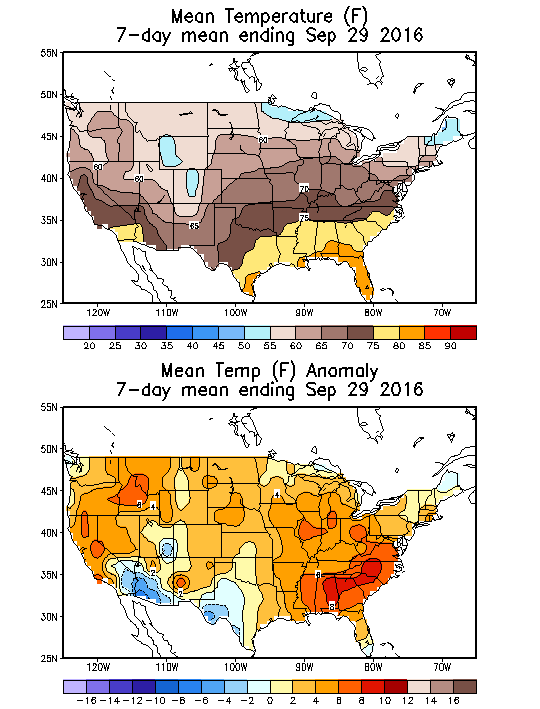
Source: NOAA/National Weather Service
Deviation between average and normal (°F)
7-Day Mean ending Sep 29, 2016

Source: NOAA/National Weather Service

